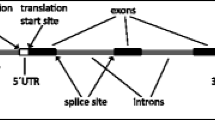Abstract
Purpose
To estimate the heritability of scoliosis in the Swedish Twin Registry.
Methods
Self-reported data on scoliosis from 64,578 twins in the Swedish Twin Registry were analysed. Prevalence, pair- and probandwise concordances and tetrachoric correlations in mono- and dizygotic same-sex twins were calculated. The relative importance of genetic variance, i.e. the heritability, and unique and shared environmental variance was estimated using structural equation modelling in Mx software. In addition, all twins in the twin registry were matched against the Swedish Inpatient Register on the primary diagnosis idiopathic scoliosis.
Results
The prevalence of scoliosis was 4%. Pair- and probandwise concordance was 0.11/0.17 for mono- and 0.04/0.08 for same-sex dizygotic twins. The tetrachoric correlation (95% CI) was 0.41 (0.33–0.49) in mono- and 0.18 (0.09–0.29) in dizygotic twins. The most favourable model in the Mx analyses estimated the additive genetic effects (95% CI) to 0.38 (0.18–0.46) and the unique environmental effects to 0.62 (0.54–0.70). Shared environmental effects were not significant. The pairwise/probandwise concordance for idiopathic scoliosis in the Swedish Inpatient Register was 0.08/0.15 for monozygotic and zero/zero for same-sex dizygotic twins.
Conclusion
Using self-reported data on scoliosis from the Swedish Twin Registry, we estimate that 38% of the variance in the liability to develop scoliosis is due to additive genetic effects and 62% to unique environmental effects. This is the first study of sufficient size to make heritability estimates of scoliosis.
Similar content being viewed by others
References
Wynne-Davies R (1968) Familial (idiopathic) scoliosis. A family survey. J Bone Joint Surg Br 50(1):24–30
Riseborough EJ, Wynne-Davies R (1973) A genetic survey of idiopathic scoliosis in Boston, Massachusetts. J Bone Joint Surg Am 55(5):974–982
Ward K, Ogilvie J, Argyle V, Nelson L, Meade M, Braun J et al (2010) Polygenic inheritance of adolescent idiopathic scoliosis: a study of extended families in Utah. Am J Med Genet A 152A(5):1178–1188
Miller NH, Justice CM, Marosy B, Doheny KF, Pugh E, Zhang J et al (2005) Identification of candidate regions for familial idiopathic scoliosis. Spine 30(10):1181–1187
Axenovich TI, Zaidman AM, Zorkoltseva IV, Tregubova IL, Borodin PM (1999) Segregation analysis of idiopathic scoliosis: demonstration of a major gene effect. Am J Med Genet 86(4):389–394
Alden KJ, Marosy B, Nzegwu N, Justice CM, Wilson AF, Miller NH (2006) Idiopathic scoliosis: identification of candidate regions on chromosome 19p13. Spine 31(16):1815–1819
Andersen MO, Thomsen K, Kyvik KO (2007) Adolescent idiopathic scoliosis in twins: a population-based survey. Spine 32(8):927–930
Neale MC, Cardon LR (1992) Methodology for genetic studies of twins and families. Kluwer Academic Publisher, Dordrecht
Kesling KL, Reinker KA (1997) Scoliosis in twins. A meta-analysis of the literature and report of six cases. Spine 22(17):2009–2014 (discussion 15)
Inoue M, Minami S, Kitahara H, Otsuka Y, Nakata Y, Takaso M et al (1998) Idiopathic scoliosis in twins studied by DNA fingerprinting: the incidence and type of scoliosis. J Bone Joint Surg Br 80(2):212–217
Lichtenstein P, De Faire U, Floderus B, Svartengren M, Svedberg P, Pedersen NL (2002) The Swedish Twin Registry: a unique resource for clinical, epidemiological and genetic studies. J Intern Med 252(3):184–205
Lichtenstein P, Sullivan PF, Cnattingius S, Gatz M, Johansson S, Carlstrom E et al (2006) The Swedish Twin Registry in the third millennium: an update. Twin Res Hum Genet 9(6):875–882
Cederlof R, Friberg L, Jonsson E, Kaij L (1961) Studies on similarity diagnosis in twins with the aid of mailed questionnaires. Acta Genet Stat Med 11:338–362
Crumpacker DW, Cederlof R, Friberg L, Kimberling WJ, Sorensen S, Vandenberg SG et al (1979) A twin methodology for the study of genetic and environmental control of variation in human smoking behavior. Acta Genet Med Gemellol (Roma) 28(3):173–195
Sarna S, Kaprio J, Sistonen P, Koskenvuo M (1978) Diagnosis of twin zygosity by mailed questionnaire. Hum Hered 28(4):241–254
Hopper JL (1998) Twin concordance. In: Armitage P, Colton T (eds) Encyclopedia of biostatistics. Wiley, Chichester, pp 4626–4629
McGue M (1992) When assessing twin concordance, use the probandwise not the pairwise rate. Schizophr Bull 18(2):171–176
Neale MC, Boker SM, Xie G, Maes HH (2006) Mx: statistical modeling, 7th edn. VCU Box 900126, Richmond,VA 23298: Department of Psychiatry
Willner S, Uden A (1982) A prospective prevalence study of scoliosis in Southern Sweden. Acta Orthop Scand 53(2):233–237
Laulund T, Sojbjerg JO, Horlyck E (1982) Moire topography in school screening for structural scoliosis. Acta Orthop Scand 53(5):765–768
Puisto V, Rissanen H, Heliovaara M, Knekt P, Helenius I (2008) Mortality in the presence of a vertebral fracture, scoliosis, or Scheuermann’s disease in the thoracic spine. Ann Epidemiol 18(8):595–601
Carter OD, Haynes SG (1987) Prevalence rates for scoliosis in US adults: results from the first National Health and Nutrition Examination Survey. Int J Epidemiol 16(4):537–544
Martin N, Boomsma D, Machin G (1997) A twin-pronged attack on complex traits. Nat Genet 17(4):387–392
Machin GA (1996) Some causes of genotypic and phenotypic discordance in monozygotic twin pairs. Am J Med Genet 61(3):216–228
Ward K, Ogilvie JW, Singleton MV, Chettier R, Engler G, Nelson LM (2010) Validation of DNA-based prognostic testing to predict spinal curve progression in adolescent idiopathic scoliosis. Spine (Phila Pa 1976) 35(25):E1455–E1464
Acknowledgments
Financial support was provided by the regional agreement on medical training and clinical research (ALF) between Stockholm County Council and Karolinska Institutet, Swedish Society of Orthopaedic Surgeons, Swedish Society of Spine Surgeons, Alfred Österlund Foundation, Hermann Järnhardt Foundation and Emil Andersson Foundation. Research funds were received from Region Skåne County Council, Karolinska Institutet and Västernorrland County Council.
Conflict of interest
None.
Author information
Authors and Affiliations
Corresponding author
Rights and permissions
About this article
Cite this article
Grauers, A., Rahman, I. & Gerdhem, P. Heritability of scoliosis. Eur Spine J 21, 1069–1074 (2012). https://doi.org/10.1007/s00586-011-2074-1
Received:
Accepted:
Published:
Issue Date:
DOI: https://doi.org/10.1007/s00586-011-2074-1




